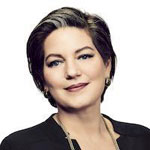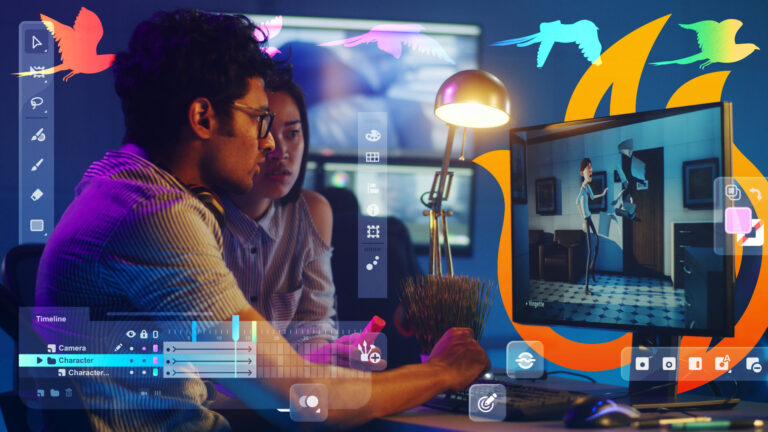Recently, OnlineEducation.com interviewed six exceptional professionals in the video game industry. They share their unique career trajectories; impressions of the industry demographics; and advice for women seeking careers in this traditionally male-dominated field. The piece was authored by Jocelyn Blore (see below for more information).
 Elisabeth Beinke-Schwartz is a senior level designer at Certain Affinity. She’s an expert in narrative design and scripting and has helped create several influential games, including DOOM, Mafia III, Call of Duty: Modern Warfare Remastered, and three BioShock Infinite titles. She has a bachelor of science degree in interactive media and game development from the Worcester Polytechnic Institute.
Elisabeth Beinke-Schwartz is a senior level designer at Certain Affinity. She’s an expert in narrative design and scripting and has helped create several influential games, including DOOM, Mafia III, Call of Duty: Modern Warfare Remastered, and three BioShock Infinite titles. She has a bachelor of science degree in interactive media and game development from the Worcester Polytechnic Institute.
 Kristina Carson is a product marketing manager at Disney Consumer Products and Interactive, where she works with popular games such as Disney Emoji Blitz. She’s also the president of Good Cookie Games LLC and served formerly as the director of marketing for Shinra Technologies, Inc. and a product marketing manager at Microsoft. She earned a bachelor of science in finance from Boston College and an MBA from Columbia Business School.
Kristina Carson is a product marketing manager at Disney Consumer Products and Interactive, where she works with popular games such as Disney Emoji Blitz. She’s also the president of Good Cookie Games LLC and served formerly as the director of marketing for Shinra Technologies, Inc. and a product marketing manager at Microsoft. She earned a bachelor of science in finance from Boston College and an MBA from Columbia Business School.
 Tricia Gray is the CEO and co-founder of Our Machinery and has more than 20 years of experience in the video games industry. She’s worked extensively in analytics, PR, and marketing. She has been the director of marketing for Cryptic Studios; the president of Freeform Communications; the marketing communications director for Unity Technologies; and the head of marketing in games services at Amazon.
Tricia Gray is the CEO and co-founder of Our Machinery and has more than 20 years of experience in the video games industry. She’s worked extensively in analytics, PR, and marketing. She has been the director of marketing for Cryptic Studios; the president of Freeform Communications; the marketing communications director for Unity Technologies; and the head of marketing in games services at Amazon.
 Elizabeth Howard has 15 years of experience at Aspyr Media—an influential, multi-platform publisher of AAA video games. She’s served as the VP of publishing for five years, and she launched an Indie Publishing program to help games reach wider audiences. She’s an expert in sales, marketing, and customer support, collaborating with distribution partners across all platforms.
Elizabeth Howard has 15 years of experience at Aspyr Media—an influential, multi-platform publisher of AAA video games. She’s served as the VP of publishing for five years, and she launched an Indie Publishing program to help games reach wider audiences. She’s an expert in sales, marketing, and customer support, collaborating with distribution partners across all platforms.
 Laura Miele has been with Electronic Arts for more than 21 years and is one of the most influential voices in the industry today. Prior to becoming the executive vice president of global publishing, she held several high leadership positions and honed her expertise in analytics, business strategy, marketing, and publishing.
Laura Miele has been with Electronic Arts for more than 21 years and is one of the most influential voices in the industry today. Prior to becoming the executive vice president of global publishing, she held several high leadership positions and honed her expertise in analytics, business strategy, marketing, and publishing.
 Melissa Preston is the art director at ArtCraft Entertainment, where she manages the creative teams behind MMO video games such as Crowfall. She has extensive experience in 3D modeling, texturing, and painting color theory. She worked formerly for nine years at KingsIsle Entertainment, where she led two large MMO art teams in making Pirate101 and a to-be-released title.
Melissa Preston is the art director at ArtCraft Entertainment, where she manages the creative teams behind MMO video games such as Crowfall. She has extensive experience in 3D modeling, texturing, and painting color theory. She worked formerly for nine years at KingsIsle Entertainment, where she led two large MMO art teams in making Pirate101 and a to-be-released title.
 Fryda Wolff is a multilingual voice actor with countless IMDb credits to her name for her work on trailers, TV shows, and video games. Notably, she was featured in Street Fighter V, Fallout 4, Civilization: Beyond Earth, The Park, Call of Duty: Advanced Warfare, Resident Evil: Vendetta, and many others. Most recently, she starred as Sara Ryder in BioWare’s Mass Effect: Andromeda.
Fryda Wolff is a multilingual voice actor with countless IMDb credits to her name for her work on trailers, TV shows, and video games. Notably, she was featured in Street Fighter V, Fallout 4, Civilization: Beyond Earth, The Park, Call of Duty: Advanced Warfare, Resident Evil: Vendetta, and many others. Most recently, she starred as Sara Ryder in BioWare’s Mass Effect: Andromeda.
Video Game Companies: Where are the Women?

“It’s interesting to see how stereotypes persist; if you really look at the statistics, core gamers are now almost evenly split between men and women, but there’s still that stereotype that core gaming is for men and casual gaming is for women.” (Kristina Carson)
Video games occupy one of the most lucrative entertainment industries on the planet. In fact, the total video game software sales in the United States alone topped $24.5 billion in 2016—up from $10.1 billion in 2009. The eSports business treats gaming as a spectator sport and is selling out massive arenas such as Madison Square Garden and the Sang-am World Cup Stadium of Seoul, which accommodates nearly 45,000 people. One recent report projected that global revenues in games would top $108.9 billion in 2017 from a stunning 2.2 billion gamers around the world. In short, the industry is on fire and shows no signs of abatement. Despite these bright prospects, the industry has left money on the table; while roughly equal proportions of American women and men are gamers—48 percent and 50 percent, respectively—some studios and hostile pockets of the gaming community have remained committed to the stereotypical white, male, hetero demographic.
The tired, old myth that gamers are all men persists today. Gary Gygax, the creator of Dungeons & Dragons, once told a reporter for Icon Magazine that, “Gaming, in general, is a male thing… Everybody who’s tried to design a game to interest a largely female audience has failed. And I think that has to do with the different thinking processes of men and women.” Leaving aside the fact that Brenda Romero—a world-renowned gaming industry professional and educator—adapted Gygax’s creation for the video game Dungeons & Dragons: Heroes, the belief in the biological determinism of gendered “thinking processes” isn’t grounded in science or history. On the contrary, the first wave of computer programmers were women. In the late 1960s, programming was dominated by intelligent, young females and interestingly, wages and prestige only began to rise in the occupation as men entered the field. One might argue that modern gaming was built on the backs of these women, and cultural—not biological—factors pushed them out.
Lorri Hopping, a game designer and writer, believes that the aggressive and exclusionary gamer culture took root in the mid-90s when hyper-masculine shooting games dominated AAA studios and online harassment of women in gaming gained steam. Most infamously, in 2014, the Gamergate scandal exposed the misogyny of the industry to the public, when game developer and community organizer Zoë Quinn had to relocate after receiving a barrage of rape and murder threats. The trolls also took aim at Anita Sarkeesian, the author of blog Feminist Frequency; her work explores the role of women in games and common tropes such as the damsel in distress, the “woman as reward,” and the sinister seductress. Notably, Gamergate inspired Zoë Quinn and Alex Lifschitz to establish the free-to-use Crash Override Network, an NGO combatting online abuse and hate groups with a crisis helpline, advocacy, and other resources. As of December 2016, the hotline has been suspended due to overwhelming demand.
As interviewee Kristina Carson rightly points out, “There’s a difference between gaming companies and gamers,” and professionals in the industry recognize the shortcomings of the field. By illustration, a survey from the International Game Developers Association (IGDA 2016) found that 67 percent of respondents who work in games believe that “sexism among gamers” was contributing to the negative perception of the industry; this was up from 55 percent in 2015 and was the top-cited concern above working conditions, sexism in games, and the perceived link to violence.
While the lack of diversity in the gaming workforce and rampant sexism in gaming communities remain problems, the indomitable spirits of six exceptional women in the business exemplify what’s right with the industry; their admirable persistence transcends stereotypes and doubt, and they are celebrated here as role models for the next generation of gaming professionals.
Women in Video Games: The Numbers

“All of it is male-dominated, but specifically I haven’t encountered many women in the senior leadership roles in publishing or engineering.” (Elizabeth Howard)
How glaring are the gender discrepancies in the gaming industry? The following is presented as a baseline measure for progress not just for women, but also for companies seeking to be more successful in a competitive industry by recognizing the value in the diverse perspectives of their consumers.
Game Industry Professionals: The Demographics
Since the game industry comprises a range of occupations, the U.S. Bureau of Labor Statistics is unable to provide accurate demographics of the industry; that said, one of the oft-cited sources in this realm is the International Game Developers Association. The IGDA (2016) surveyed workers across all roles—mainly concentrated in development, including QA—and reported that only 23 percent of industry respondents were women, and 81 percent were Caucasian. All of the interviewees for this story acknowledged the male-dominance of the industry.
Game Industry Professionals: Salaries
Another IGDA (2016) survey reported that there were three times as many men as women earning $150,000 or more. Also, 41 percent of men reported earning more than $75,000, compared to only 35 percent of women. Furthermore, 41 percent of women reported incomes between $40,000 and $75,000, while only 29 percent of men fell into this bracket. It’s important to add that while the sacrifices of childrearing are often cited to account for these glaring differences, 36 percent of the men and only 17 percent of the women reported having children living at home.
In a 2014 survey, Gamasutra found a similar wage disparity in the industry, reporting that among video game developers, men made an average annual salary of $85,074 in 2013, compared to $72,882 for women; this equates to 86 cents on the dollar.
Gamers: The Demographics
As mentioned in the introduction, nearly half of American women are gamers (48 percent). The Entertainment Software Association (2017) found that more than 150 million Americans play video games across 65 percent of the country’s households. Seventy-seven percent of men aged 18 to 29 play games—a larger share than any other demographic group—and 57 percent of young women in this age cohort do; this gender gap decreases substantially in older age groups.
The difference lies in the proportion of people identifying as gamers; men are twice as likely as women to call themselves gamers. It’s also worth noting that only 26 percent of people who play don’t think that women are poorly portrayed in video games.
Characters in Games: The Demographics
Perhaps the greatest disjunction is in-game characters. According to Anita Sarkeesian’s blog Feminist Frequency, there were 109 games unveiled at E3 in 2017; seven percent (eight games) starred female characters, compared to 26 percent (29 games) with male protagonists. Fifty-two percent allowed players to choose the gender.
An academic study entitled “Sexy, Strong, and Secondary: A Content Analysis of Female Characters in Video Games across 31 Years” was published last year in the Journal of Communication. The researchers analyzed content from 571 titles released from 1983 to 2014 with playable female characters. Interestingly, they found that the 1990s—again, when AAA studios began ramping the production of hyper-masculine, shooter-games—the over-sexualization of female characters was at its height. Sexualization was defined as presenting nudity, enlarged breasts or hips, and ludicrously narrow waists. Check out the evolution of Tomb Raider’s Lara Croft for a clear example of these trends; the emphasis on her massive breasts, narrow waist, and long bare legs has finally made way for a more practical, survivalist attire.
Barriers to Women Working in Video Games

“One of the guys who I kind of knew told me, ‘You know, we really like you and we really like your work, but we’re just concerned about having a girl in the office.’” (Melissa Preston)
VIDEO GAMES: WHY ARE THERE SO FEW WOMEN IN THE INDUSTRY?
- The Expectation Gap
- The Education Gap
- The Domestic Responsibilities Gap
- The Role Model Gap
- The Civility Gap
In speaking with these six professionals about their perception of the games industry, several themes emerged which clarified the unique challenges that women and other underrepresented groups face.
The Expectation Gap
Several of the interviewees brought up the ouroboros of the games industry—in other words, the way that the expectations of predominantly male power-holders feed a self-perpetuating cycle. As detailed above, many people assume that gamers are overwhelmingly male, which impacts who’s hired in the business; many people wrongly believe that women simply don’t know as much about games and condescend to even the most experienced women in the industry. Ms. Howard stated, “I think that women have to prove it more than a man in a similar role. I’ve seen men in roles in which their title is bigger than their work…I think men benefit from being assumed to be great or capable.” This dovetails with recent studies showing that men are promoted based on potential—i.e., what they haven’t yet achieved but people assume to be there—while women, if they’re promoted at all, are judged on what they’ve already accomplished. Furthermore, men are more likely to receive credit for professional achievements and most alarmingly, women’s competence can make them seem “unlikeable;” as a result, women in gaming and other industries are forced to walk a razor’s edge to advance in some workplaces. Ms. Gray summarized the problem succinctly: “When it came time for the money, promotions, or getting projects done, you could see it blazing in your face: you are not part of this boys’ club, and I’ve been trying my entire career.”
There’s a cycle of under-representation—especially in game studio leadership—and this can feed women’s unwillingness to apply for jobs in the sector; the decades of pandering to the male core-gaming demographic—not to mention the rampant online abuse suffered by women in the industry and gamers themselves—have discouraged many from seeking jobs.
The Education Gap
It’s no secret that women and people of color are less likely to pursue degrees in STEM, computer science, and other technical fields. A recent study found that only 6.7 percent of women graduate with STEM degrees, compared to 17 percent of men; in other words, men are 2.5 times as likely to achieve degrees in these disciplines. A similar gap exists for people of color. While the reasons for these disparities are beyond the scope of this article, some common explanations include continued discrimination against women in the sciences; a lack of role models; and the toxic (and faulty) assumptions about men and women’s inherent capabilities in these fields.
The Domestic Responsibilities Gap
Despite recent gains, women still take on a larger share of the domestic responsibilities—what Arlie Hochschild called “The Second Shift”—even when they work similar hours as their partners. On an average day, women spend nearly twice as much time performing household activities, including cooking, cleaning, and taking care of children. Several of the interviewees shared their struggles with this balance. Ms. Howard put it bluntly: “Women often bear more responsibility at home…I’m fortunate to work for a company and bosses that really value family, but I see male counterparts in the industry that aren’t juggling as many balls and therefore have a lot more freedom to focus solely on their careers.” Ms. Carson also shared her view on women’s career interruptions: “People disagree with me all the time, but I maintain my assertion that women have harder choices to make than men in this country in terms of career when it comes to family.” She went on to share that many women simply don’t return to work: “The only way we can combat a lot of that is through huge government reforms surrounding maternity leave. Also, it’s about sharing those responsibilities. For a lot of my friends who have children, it actually doesn’t make financial sense for them to go back to work because childcare is so expensive.” Furthermore, there’s evidence that women take on more of the mental and emotional work of childcare and domesticity, including organizing activities and even worrying.
Also, while some people believe that women aren’t attracted to working in games due to the practice of “crunch time”—intense periods where people work 50-70 hours per week to complete a game, for example—other professions with similar seasonal responsibilities (e.g., accounting, law) don’t have such glaring gender disparities.
The Role Model Gap
The current lack of female leaders in the games industry is discouraging; Ms. Carson stated the problem clearly: “It’s tough to be one of the pioneers; being that only woman in the room can be daunting…We face so much sexism in many scientific and technical industries—gaming being one of them—and I don’t blame women for not being more represented; you can’t blame the victim here.” Ms. Beinke-Schwartz, a senior level developer at Certain Affinity, added that “It would help to take a look at hiring practices and see if there’s an issue with the pipeline that might be leaking potentially awesome candidates. Also, just advocating for female employees and promoting them in outward-facing roles.”
This phenomenon also extends to the characters in games themselves; Ms. Wolff stated memorably, “I see a lot of writers’ room crap; I can tell when a white, hetero-male has written something because of how two-dimensional the female characters are.” When a person doesn’t have characters with whom she can identify, why would she want to enter the industry? Again, game companies are leaving a lot of money on the table by limiting the diversity of their casts.
The Civility Gap
All of the interviewees shared anecdotes of how they or female colleagues had been discriminated against. Ms. Carson revealed, “I have a friend who was a community manager in gaming for many years at a pretty major company, and she eventually left because she got so many threats. Every day she would get threats to her personally and to her family. They would say they hoped someone would come to her home and rape her or make comments about her looks, talking about her breast size or her face.” Ms. Gray remarked that the mistreatment of women in gaming is nothing new: “For the most part, it’s been a male-dominated industry. I felt weird because all the stuff that happened with Zoë Quinn and Gamergate—this stuff happened to us back in the day all the time.”
Ending the Toxic Status Quo

“There are certain shows, creators, and studios where you can tell they’re working really hard for gender parity…Once in awhile, they’ll ask for someone of a specific ethnic heritage because the character is of that ethnic heritage, and they want to do right; they don’t want anyone to have to pretend or play a racial stereotype, which is very distasteful these days.” (Fryda Wolff)
The above paints a troubling picture for the games industry, but there are several signs of improvement. The aforementioned IGDA (2016) survey found that 78 percent of game development professionals believed diversity in the workplace was “very” or “somewhat important,” up from 63 percent in 2015. And some companies are putting their money where their mouth is. Following Gamergate, Intel pledged $300 million to an initiative called “Diversity in Technology.” Also, at the 2017 Game Developer Conference in San Francisco, Ubisoft hosted a panel entitled “World Building: The Power of Developers in Representing Diversity.”
Other companies are devising ways to discourage sexist behaviors. For example, Riot Games’ League of Legends—interviewee Kristina Carson’s game of choice—has hired a team of social researchers to study the interactions between its roughly 67 million users. They’re studying where toxic behavior originates and developing schemes to encourage players to be more civil to one another.
Finally, there’s a wealth of organizations taking aim at the gaming industry’s lack of diversity. These include:
- AnyKey
- Black Girls Code
- Crash Override Network
- Feminist Frequency
- Gamer Women
- Girls Who Code
- IGDA: Women in Games
- The 22 Percent Project (Gram Games)
- Women in Games WIGJ
- Women in Games International
Career Advice for Women in Video Games

“I implore other women: if you see something wrong that’s happening, speak up, put the paper trail together, get all of the data that helps you prove your point, and don’t let anybody push you around. That’s how they win.” (Tricia Gray)
ADVICE FOR THE NEXT GENERATION OF VIDEO GAME PROFESSIONALS
- Don’t listen to naysayers; focus on supporters.
- Know the benefits of diversity, socio-culturally and business-wise.
- Acknowledge that it’s tough to be a pioneer in an industry with so few women; talk about it and be visible to others.
- Don’t get complacent with small gains.
- Go over, under, or through.
- Be an unshakable self-advocate.
- Apply for jobs even if you don’t meet 100 percent of the qualifications.
- Mentor the next generation of women and other underrepresented groups in the business.
- Celebrate the heroes—past and current—in the industry.
Lastly, Elisabeth Beinke-Schwartz, Kristina Carson, Tricia Gray, Elizabeth Howard, Melissa Preston, and Fryda Wolff shared their advice for women seeking careers in the games industry, paying thought to their own experiences. What was clear is that despite being among the only women in the room, their love of the industry and ironclad resolve make them some of the most gifted, committed professionals in the business today. Here’s what they had to say:
Don’t listen to naysayers; focus on supporters. While female gamers and professionals may face outright discrimination and harassment, those who focused their energy on supporters were richer the experience. Ms. Howard paid credit to her mother and her great aunt, stating, “Both of these women showed me what female ambition and success looked like. I never questioned my ability to thrive and succeed in my career just because I was a woman. I also saw the value of working hard for what you want in life.” Ms. Wolff recounted how Joan Jett “started playing gigs as a fifteen-year-old in the early 70s, and she was always told, ‘Uh, sweetheart, women don’t belong in rock. Rock’n’Roll isn’t a thing that women do.’ She was like, ‘Cool. Watch me.’ And then, the rest is history.”
Know the benefits of diversity, socio-culturally and business-wise. Several of the women brought up the importance of having diverse voices at the table, particularly from a business perspective. Ms. Howard stated, “Having all voices represented is critical to the success of any company—and frankly, of society—so it’s important to figure out how to get that balance.” Ms. Gray shared that view and said, “People need to know that diversity isn’t a scary thing; it’s actually a really beautiful thing that can help people solve problems and see different perspectives, and really make a company flourish.” There’s abundant evidence that diverse company teams are more innovative, as a variety of perspectives contributes to more nimble approaches and different ideas; by extension, it’s in the best interest of companies to increase their diversity if they want to stay competitive.
Acknowledge that it’s tough to be a pioneer in an industry with so few women; talk about it and be visible to others. Part of breaking the cycle is not only to recognize the unique difficulties women face, but also being vocal about it. All of the interviewees acknowledged that change is slow, but persistence and visibility are paramount. Ms. Wolff shared, “I’m a student of feminists and successful women. The thing that they all seem to have in common is that they just didn’t quit…Whatever you want to do for a living, you’re going to get some cuts and bruises, and that’s fine because it’s not the first time, and you’re not the only one.” Ms. Beinke-Schwartz, recognizing that she’s one of the few female senior level designers, has spoken at many prestigious conferences and stated, “I’ve also tried to just get out there more by way of speaking and interviews like these to help put a female face to leadership in video games. I think the more people see women doing a variety of jobs within the industry, the more likely incoming generations will feel comfortable going for those types of careers.” Ms. Howard put it candidly: “Something that also drives me is the feeling that I need to be more public, not because I personally want to be more visible, but because seeing a woman in a higher-level role—someone who is present—is really valuable to younger women and girls.” Ms. Preston also mentioned the importance of having women seen in impactful roles: “Until more women get into leadership positions, they won’t be able to influence these studios.”
Don’t get complacent with small gains. Two of the interviewees stated the importance of continuing to push for increasing diversity; Ms. Wolff said, “If we ever get complacent with, ‘This is good enough,’ it will immediately backslide. As current politics show, the second you get complacent and lazy, everything backslides.” Ms. Gray shared that sentiment, putting it bluntly: “The other thing is don’t be silent! You can’t be complacent. If something fucked up is going on, you’ve got to speak up and say something.”
Go over, under, or through. Ms. Wolff mentioned advice from Tina Fey’s Bossypants: “If you can’t work with a guy, go under him—not literally—over him, or through him. Do whatever it takes to pass them and leave them behind because if you really believe in the thing that you want to accomplish, they can’t stop you.”
Be an unshakable self-advocate. Women should be encouraged to draw attention to their accomplishments. Ms. Howard shared, “I’ve never been afraid to ask for what I want, what I need, or what I deserve, and my career has benefitted…Advocate for what you need; what you do; and what your value is.” Ms. Wolff related this feeling to other underrepresented groups in the industry and said, “Women, minorities, and other people you think you can push aside are suddenly very authoritative when they realize their value and stand up for themselves. Women have a lot of power. We’re just told constantly that we don’t, so we believe it, but the trick is: don’t believe it.”
Apply for jobs even if you don’t meet 100 percent of the qualifications. Related to the importance of being a self-advocate, Ms. Beinke-Schwartz mentioned, “Make sure you apply for jobs even if you don’t feel like you match 100 percent of the qualifications. There have been studies that say a lot of men will apply for a position when they meet only 60 percent of the qualifications, but for women, they often will not apply until they meet 100 percent.”
Mentor the next generation of women and other underrepresented groups in the business. Ms. Beinke-Schwartz affirmed that mentoring is mutually beneficial: “It’s very rewarding because sometimes when you’ve been working somewhere for awhile, you get a little jaded, and seeing the enthusiasm of younger folks who are really excited and passionate kind of re-energizes you. It’s a two-way street there for mentoring.”
Celebrate the heroes—past and current—in the industry. Perhaps the most important takeaway from this story is to honor the incredible women in games and highlight their accomplishments to encourage future generations. Ms. Gray revealed, “I just watched Hidden Figures and I cried through the whole thing. Why weren’t these people in my history books?” Similarly, this piece pays tribute to the women gamers and industry professionals who have made the road a little more navigable for the rest of us.
- Dona Bailey (programmer)
- Elisabeth Beinke-Schwartz (level designer)
- Danielle Bunten Berry (designer and programmer)
- Kristina Carson (product marketing manager)
- Nacia Chambers (executive)
- Shannon Donnelly (designer)
- Kirsten Duvall (business development director)
- Tracy Fullerton (director)
- Tricia Gray (cofounder and executive)
- Emily Greer (gaming company cofounder)
- Jennifer Hale (voice actor)
- Tasha Harris (animator and designer)
- Amy Hennig (director and script-writer)
- Elizabeth Howard (executive)
- Chelsea Howe (creative director)
- Robin Hunicke (producer)
- Pauline Jacquey (director)
- Jane Jensen (designer)
- Blanca Juti (executive)
- Heather Kelley (media artist and designer)
- Amy Jo Kim (executive)
- Rieko Kodama (artist and director)
- Carla Meninsky (designer)
- Kathy Preston (publisher)
- Melissa Preston (art director)
- Jade Raymond (executive)
- Brenda Romero (designer and developer)
- Bonnie Ross (developer and executive)
- Kellee Santiago (designer and producer)
- Carol Shaw (designer)
- Yoko Shimomura (composer)
- Kim Swift (designer)
- Siobhan Reddy (director)
- Margaret Wallace (executive)
- Fryda Wolff (voice actor)
- Kiki Wolfkill (executive)
- Roberta Williams (designer and studio co-founder)
- Corrinne Yu (programmer)
About the Author: After graduating from UC Berkeley, Jocelyn Blore traveled the world for five years as a freelance writer. She lived in Japan, Brazil, Nepal, and Argentina. In 2015, she took an 11-month road trip across the US, finally settling into Eugene, Oregon. She currently serves as the managing editor for several websites on distance-based programs in nursing, engineering and other disciplines. When Jocelyn isn’t writing about schools or interviewing professors, she enjoys satirizing global absurdities on her blog, Blore’s Razor.



